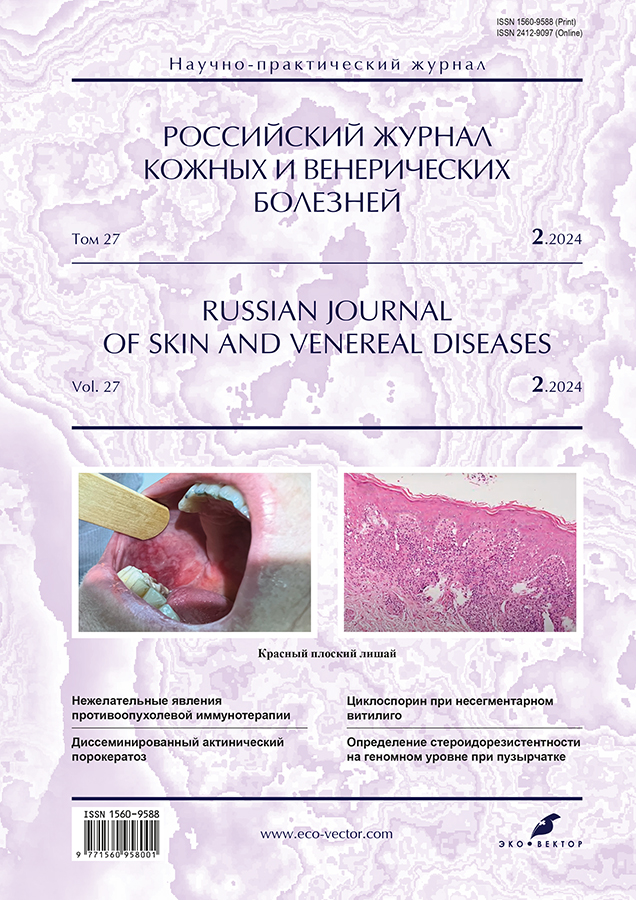Retrospective evaluation of the effectiveness and safety of UVB-311 in atopic dermatitis
- Authors: Kochergin N.G.1, Abdulridha A.1
-
Affiliations:
- I.M. Sechenov First Moscow State Medical University
- Issue: Vol 27, No 2 (2024)
- Pages: 201-208
- Section: DERMATOLOGY
- Submitted: 01.11.2023
- Accepted: 17.03.2024
- Published: 14.05.2024
- URL: https://rjsvd.com/1560-9588/article/view/622927
- DOI: https://doi.org/10.17816/dv622927
- ID: 622927
Cite item
Abstract
BACKGROUND: Atopic dermatitis is a widespread skin disease based on immune and genetic mechanisms of chronic inflammation formation. The disease most often develops in early childhood, has a frequent recurrent course, age-related clinical features. In this regard, the disease is characterized by a wide variety of treatment methods, the effectiveness of which varies and is a highly debated topic at the present time.
AIM: to retrospectively evaluate the efficacy and safety of standard local and systemic therapy of atopic dermatitis in combination with UVB 311 nm.
MATERIALS AND METHODS: 100 case histories of patients with atopic dermatitis of varying severity who were in the clinic of skin and venereal diseases in the period from 2022 to 2023 were analyzed. Of these, 50 patients received combined systemic and topical therapy with UVB 311 nm (the first group), and 50 patients received only standard topical and systemic therapy (the second group). Systemic and topical therapy of atopic dermatitis included, according to clinical recommendations, corticosteroids, calcineurin inhibitors, antihistamines.
RESULTS: As a result of combined therapy with UVB 311 nm, patients showed a decrease in the SCORAD index by 1.7 times after 1 month of therapy, by 8 times after 2 months, and by 30 times after 6 months. In the second group, the SCORAD index decreased 1.2 times after 1 month from the start of therapy (p=0.0004), 3 times after 2 months (p=0.0001), 20 times after 6 months (p=0.003). Side effects in the first group were detected only in 5 (10%) patients: 2 (4%) patients had skin burning, 2 (4%) had skin itching, 1 (2%) patient had photodermatitis in the form of erythema of the skin. These adverse reactions were of a short-term nature and quickly passed if the recommendations were followed without canceling the procedures.
CONCLUSION: UVB 311 nm therapy for atopic dermatitis has a higher therapeutic effect, is well tolerated, has minimal early side effects, and leads to clinical remission faster than standard systemic and local therapy.
Keywords
Full Text
About the authors
Nikolay G. Kochergin
I.M. Sechenov First Moscow State Medical University
Author for correspondence.
Email: nkocha@yandex.ru
ORCID iD: 0000-0001-7136-4053
SPIN-code: 1403-3031
MD, Dr. Sci. (Med.), Professor
Russian Federation, MoscowAli Hussein Abdulridha
I.M. Sechenov First Moscow State Medical University
Email: alsadiali901@gmail.com
ORCID iD: 0000-0003-1156-1762
Russian Federation, Moscow
References
- Olisova OYu, Vladimirov VV, Muraxovskaya EK. Uva 370 nm phototherapy of atopic dermatitis. Russ J Skin Venereal Dis. 2013;(6):22–27. EDN: RTHZZB
- Olisova OY, Monaxov SA, Korchazhkina NB. Narrow-band 311 nm phototherapy of patients with atopic dermatitis. Russ J Skin Venereal Dis. 2012;(3):25–27. EDN: RTHZZB
- Frazier W, Bhardwaj N, Frazier W, et al. Atopic dermatitis: Diagnosis and treatment. Am Fam Physician. 2020;101(10):590–598.
- Wollenberg A, Barbarot S, Bieber T, et al. Consensus-based European guidelines for treatment of atopic eczema (atopic dermatitis) in adults and children: Part I. J Eur Acad Dermatol Venereol. 2018;32(5):657–682. doi: 10.1111/jdv.14891
- Gregory I, Marshall H, Gregory I, et al. Cochrane corner: Phototherapy for atopic eczema. Clin Exp Allergy. 2023;53(1):7–9. doi: 10.1111/cea.14230
- Tétart F, Joly P, Tétart F, et al. Eczema in elderly people. Eur J Dermatol. 2020;30(6):663–667. doi: 10.1684/ejd.2020.3915
- Bogaczewicz J, Malinowska K, Sysa-Jedrzejowska A, Wozniacka A. Medium dose ultraviolet A1 phototherapy and mRNA expression of interleukin 8, interferon-γ, and chemokine receptor 4 in acute skin lesions in atopic dermatitis. Postepy Dermatol Alergol. 2016;33(3):170–175. doi: 10.5114/ada.2016.60609
- Dogra S, Mahajan R. Indian association of dermatologists, venereologists and leprologists. Phototherapy for atopic dermatitis. Indian J Dermatol Venereol Leprol. 2015;81(1):10–15. doi: 10.4103/0378-6323.148557
- Patrizi A, Raone B, Ravaioli GM. Management of atopic dermatitis: Safety and efficacy of phototherapy. Clin Cosmet Investig Dermatol. 2017;(8):511–520. doi: 10.2147/CCID.S87987
- Vladimirov VV. Classification of skin phototypes for administration of an efficient phototherapy. Vestnik dermatologii i venerologii. 2009;(4):65–67. EDN: KYQHGL
- Musters AH, Mashayekhi S, Harvey J, et al. Phototherapy for atopic eczema. Cochrane Database Syst Rev. 2021;10(10):CD013870. doi: 10.1002/14651858.CD013870.pub2
- Chan CX, Zug KA, Chan CX, et al. Diagnosis and management of dermatitis, including atopic, contact, and hand eczemas. Med Clin North Am. 2021;105(4):611–626. doi: 10.1016/j.mcna.2021.04.003
- Chia BK, Chia GS, Tan ST, et al. Ultraviolet-A1 phototherapy in Asian skin: A review of 159 cases in Singapore. Indian J Dermatol Venereol Leprol. 2020;86(2):162–168. doi: 10.4103/ijdvl.IJDVL_751_17
Supplementary files









